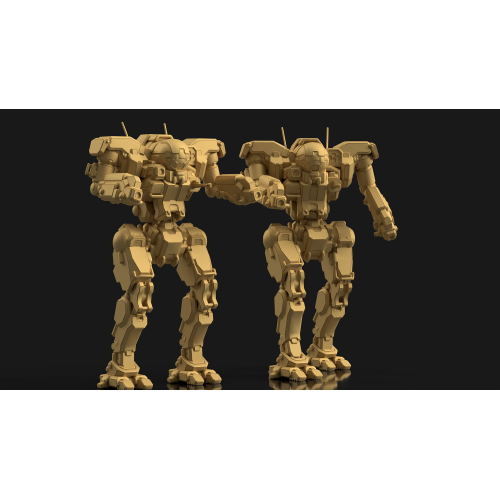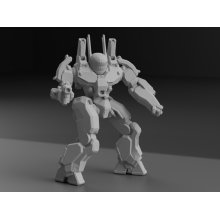The Vulcan VLK-5P "Eclipse" was born out of necessity during the Fourth Succession War (3028-3030), as the Free Worlds League found itself engaged in protracted skirmishes along the Capellan border. With ammunition shortages plaguing frontline units and the Vulcan’s traditional anti-infantry role becoming less relevant due to declining battle armor use, the 5P variant was developed as a field refit to extend battlefield endurance without reliance on supply lines.
Designed by engineers from Irian BattleMechs Unlimited, the Eclipse focused on maintaining the Vulcan’s speed and harassment potential while replacing its autocannon with a Large Laser, giving it sustainable ranged firepower. The addition of Medium Lasers and an SRM-4 preserved its close-quarters lethality, while a machine gun and AMS ensured it could still perform infantry suppression and survive missile-heavy encounters.
Though initially a stopgap solution, the Eclipse proved to be a highly effective harasser, engaging enemy light and medium 'Mechs in extended hit-and-fade battles. It was particularly effective against Davion reconnaissance forces, as its energy-based loadout freed it from logistical constraints that plagued conventional AC/2-armed Vulcans.
Deployment History
Despite being an unofficial field refit at first, the Eclipse was recognized for its success in the Battle of New Olympia (3029), where Free Worlds League forces used it to cripple the supply lines of the 5th Syrtis Fusiliers. A squadron of Eclipse Vulcans led by Captain Elias Halworth disrupted Davion logistics convoys for weeks, forcing House Davion to redirect heavier assets to deal with what was supposed to be a mere reconnaissance force.
This battle cemented the Eclipse’s reputation as a raider’s 'Mech, valued for its ability to operate independently for long periods. By 3035, Irian BattleMechs Unlimited had begun producing limited numbers of the VLK-5P Eclipse for select League regiments, particularly those operating along the periphery or deep behind enemy lines.
By the Clan Invasion era (3050s), the Eclipse was still in use among older Marik regiments and mercenary companies, though it was often overshadowed by newer, more advanced designs. Nevertheless, its reliability and self-sufficiency ensured its survival well into the late 31st century, particularly among independent forces who valued its ability to remain effective with minimal resupply.
Legacy and Reputation
The Vulcan "Eclipse" is often associated with stealth, speed, and precision strikes, earning its moniker from the way it seemed to appear out of nowhere in battle, striking swiftly before vanishing back into the terrain. Though lacking the raw firepower of heavier 'Mechs, its mobility and self-sufficiency made it a favorite among skilled pilots who preferred tactical play over brute force.
While never mass-produced like the standard Vulcan, the Eclipse became a prized variant in mercenary circles, often passed down through generations of independent warriors who appreciated its rugged versatility. Even as technology advanced, some modified Eclipses persisted in the Inner Sphere, refitted with double heat sinks and upgraded weaponry for modern battlefields.
The Eclipse stands as a testament to battlefield adaptability, proving that even a 'Mech designed for one role can evolve to meet new challenges and endure across centuries of warfare.
Notable Pilots
Captain Elias Halworth (Free Worlds League) – Led a unit of Eclipse Vulcans during the Battle of New Olympia, using them to disrupt Davion logistics and turn the tide of the engagement.
"Whisper" Nadine Corvalis (Mercenary) – A skilled raider who operated along the Taurian border, using an Eclipse with upgraded armor and heat sinks to execute high-risk, deep-strike missions.
Lieutenant Renzo Castille (Marik Militia) – Used his Eclipse to single-handedly hold a mountain pass against a Lyran recon lance during the War of 3039, utilizing terrain and hit-and-run tactics.









